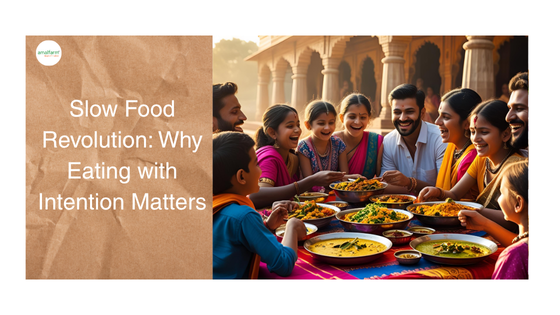Copyright © 2023 Amalfarm. All Rights Reserved.


Ever notice how meals seem to rush by these days? One minute, you’re unwrapping a sandwich at your desk; the next, you’re wondering where it went. I’ve been there too—eating just to get it over with. But lately, I’ve started to wonder: What if we hit the pause button?
What if we made eating an experience again, not just a chore?
This is where the Slow Food Revolution comes in. It’s not just a fancy trend from foodies in Italy. It’s a way of living, a gentle rebellion against the speed and sameness of modern life. And honestly? It’s changed the way I look at my plate.

Let me take you back to a memory. When I was a kid, Sunday lunches at my grandmother’s house were a big deal. The table would be set with mismatched plates, the air heavy with the smell of her slow-cooked stew. We’d all gather, chat, laugh, and eat. No one rushed. No one checked their phones. Those meals lingered, not just on our tongues, but in our hearts.
Compare that to now. How often do we eat alone, distracted, barely tasting our food? The Slow Food movement asks us to bring back those moments. To savor, to connect, to be present.

It all started in Italy in the 1980s. People were worried that fast food chains would wipe out their local food culture. So, they pushed back. They celebrated traditional recipes, local farmers, and the simple pleasure of a shared meal. It wasn’t just about food—it was about community, sustainability, and taking pride in where you come from.
Also Read: Make Food Your Medicine So Medicine Doesn’t Be Your Food: Healthy Eating Tips 101
Today, the movement has spread across the globe. It’s not about fancy ingredients or complicated recipes. It’s about eating with intention—choosing what you eat, how you eat, and why you eat it.

Ever scarfed down a meal and felt bloated or unsatisfied? When you slow down, your body has time to register fullness. You actually taste your food. You might even discover you don’t need as much as you thought.
There’s something calming about eating slowly. It’s almost meditative. You notice the crunch of a carrot, the warmth of soup, the sweetness of a ripe peach. Suddenly, eating becomes a break from the chaos, not just another thing to check off your list.
When you eat with intention, you start to care about where your food comes from. Maybe you pick up veggies from the farmer’s market instead of the supermarket. Maybe you try a recipe your mom used to make. Every choice is a small act of care—for yourself, for your community, for the planet.

Honestly, you don’t need to move to the countryside or grow your own tomatoes (unless you want to!). Here are a few things I’ve tried that made a real difference:
Try cooking something from scratch. It doesn’t have to be fancy—a simple soup or salad counts.

Here’s the thing: when you start eating with intention, it spills over into other parts of your life. You might find yourself slowing down in general, paying more attention, feeling more grateful. Meals become moments to look forward to, not just fuel stops.
I’m not perfect at this. Some days, I still eat lunch at my laptop. But more and more, I find myself craving those slow, intentional meals. The ones where I actually taste my food, where I feel connected—to the people around me, to the world, even to myself.

The Slow Food Revolution isn’t about rules or guilt. It’s about rediscovering the joy of eating. It’s about making meals matter again. Next time you sit down to eat, try slowing down. Taste. Savour. Connect. You might be surprised at how much richer life feels—one bite at a time.
If you’re still reading, maybe you’re hungry for more than just food. Maybe you’re ready for a little revolution of your own. Why not start tonight? Set the table, invite someone over (or just yourself), and see what happens when you eat with intention.
Have a question?
